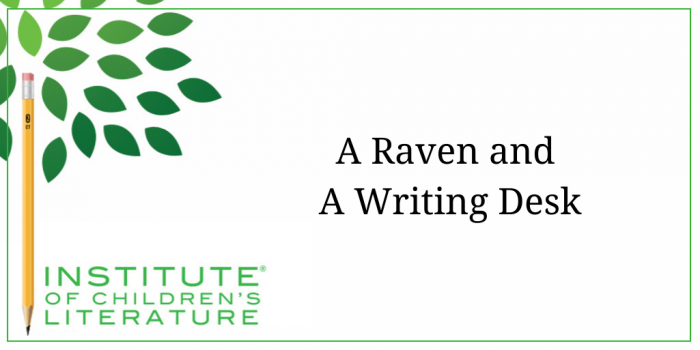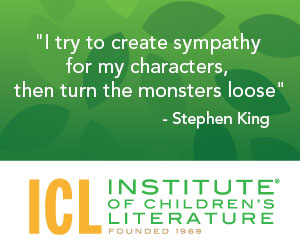1000 N. West Street #1200, Wilmington, DE 19801
© 2024 Direct Learning Systems, Inc. All rights reserved.

We teach our students how to write and get published!
View our Course Catalog >

When Lewis Carroll first wrote the riddle about the raven and the writing desk, he didn’t have an answer. It was simply a riddle to stump a little girl, something nonsensical as might come up in a dream. But over time people have pondered it like a real riddle. “How is a raven like a writing desk?”
Over time, even Lewis came up with an answer: “Because it can produce a few notes, though they are very flat, and it is never put with the wrong end in front!” Though an interesting answer, it has not been enough for riddle lovers. Others have come up with still more answers. “They both have quills dipped in ink.” “Poe wrote on both.” “Neither is ever approached without caws.” “A writing desk is a rest for pens and a raven is a pest for wrens.” Or Aldous Huxley’s wonderfully nonsensical answer: “Because there is a b in both, and an n in neither.” And here’s mine: having one in your house is the road to insanity. (Can you tell I’m a huge Poe fan?)
You see there are a lot of possible answers for Lewis’ riddle, if you think about it. And riddles help us make connections to things. And connections make us better writers. They make us reach for stronger and more interesting metaphors and similes. They help us think more deeply about things and that is the very soul of the creative process.
Let’s play a game
So take some time to compare two very different, completely unrelated things. Tell how they are alike or how they are connected. Ask yourself: how is a kitten like a peach? Healthy ones are quite plump? Both are fuzzy? Both are sweet?
Look around your work area right now, and pick two things at random. How are they are same?
How is a spoon like a pencil? Here’s my top-of-the-head answer: “in skilled hands, they can both produce masterpieces.”
How is a calendar like a pill bottle? How about: “if I take the contents of one, I’ll live to see more of the contents of the other.” Yeah, that might have been a little lame. See if you could do something better.
How are eye glasses like a cell phone? “Without one, I can’t use the other.” Or “they’re both constantly getting misplaced.”
How is a bottle of glue like a paper clip? (Okay, that one is easy.)
Check out the things on your desk. Pick any two and come up with ways they are the same or are connected. As you go through your day, try that in other rooms. This may seem silly but it’ll accomplish two things. It’ll make you better at connections and that makes you a better writer. And it’s exercise for your brain and anything that helps keep your brain sharp is going to pay off for your writing as well.
Try it with people
You can take the connections game still further and use it to compare totally different people. You can pick people you know personally: how is your best friend like the person who annoys you most? You can pick famous people: how is Prince William like Will Smith? You can pick people from history: How is George Washington like Rosa Parks? Much like the object connections, this kind of exercise can make you think deeper about people. It can also force you to do a tiny bit of research (even if it’s just to call up photos of Will Smith and Prince William). It can help you begin to look at people differently. This is especially a great exercise if the historical pair contains someone history has declared a hero and someone history has declared a villain. So how was Benito Mussolini like Winston Churchill? Again, that’s likely to require some research, but if you avoid the obvious answers (both men, both balding) you will likely come away with a deeper understanding and (more importantly) some insight into how we judge people.
Being able to see how the characters you create have things in common (and things that differ) will make it easier for you to come up with situations where they clash (because conflict is the attention-grabbing gold in a story) and easier for you to make them feel real. And that makes you a better writer. And there’s always the brain exercise benefit as well.
And while you’re at it. What do you think? How is a raven like a writing desk?
With over 100 books in publication, Jan Fields writes both chapter books for children and mystery novels for adults. She’s also known for a variety of experiences teaching writing, from one session SCBWI events to lengthier Highlights Foundation workshops to these blog posts for the Institute of Children’s Literature. As a former ICL instructor, Jan enjoys equipping writers for success in whatever way she can.
1000 N. West Street #1200, Wilmington, DE 19801
© 2024 Direct Learning Systems, Inc. All rights reserved.
1000 N. West Street #1200, Wilmington, DE 19801
© 2024 Direct Learning Systems, Inc. All rights reserved.
1000 N. West Street #1200, Wilmington, DE 19801
© 2024 Direct Learning Systems, Inc. All rights reserved.
1000 N. West Street #1200, Wilmington, DE 19801
© 2025 Direct Learning Systems, Inc. All rights reserved.
1000 N. West Street #1200, Wilmington, DE 19801
©2025 Direct Learning Systems, Inc. All rights reserved. Privacy Policy.